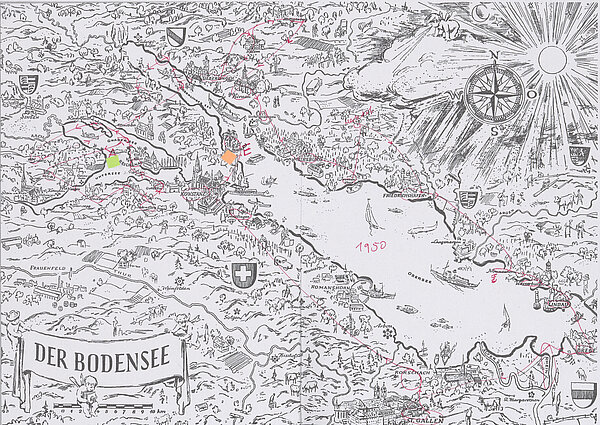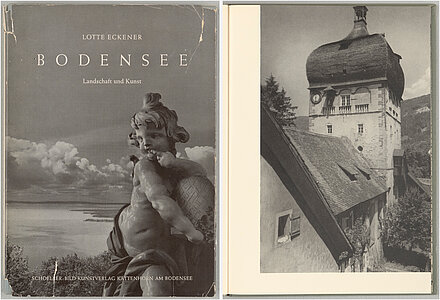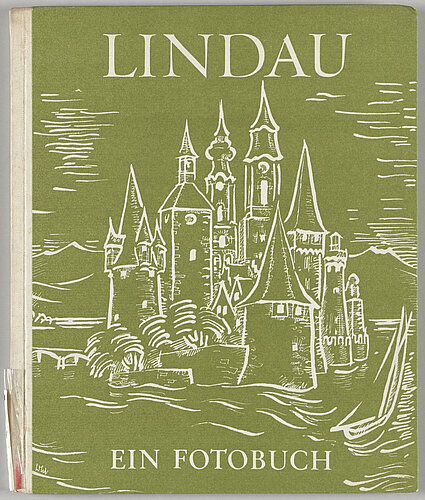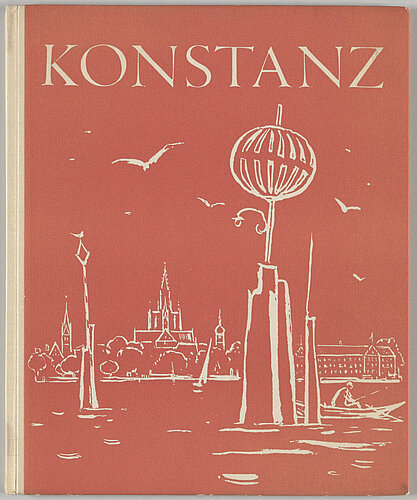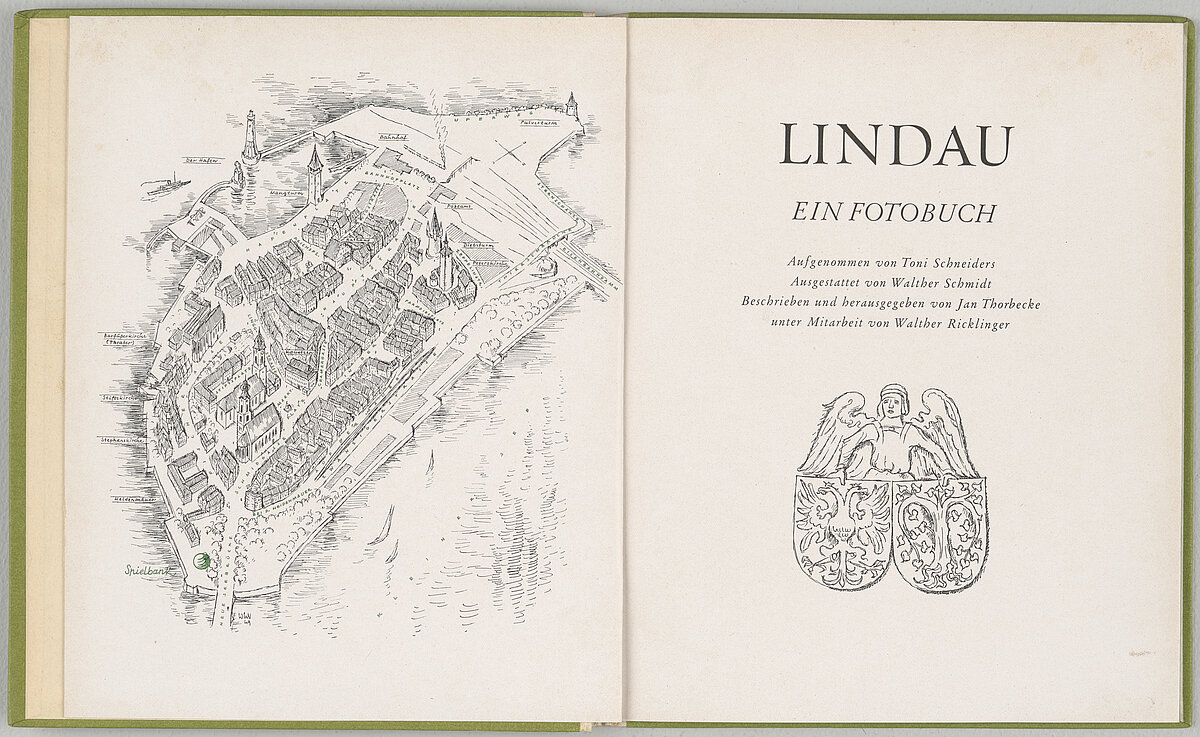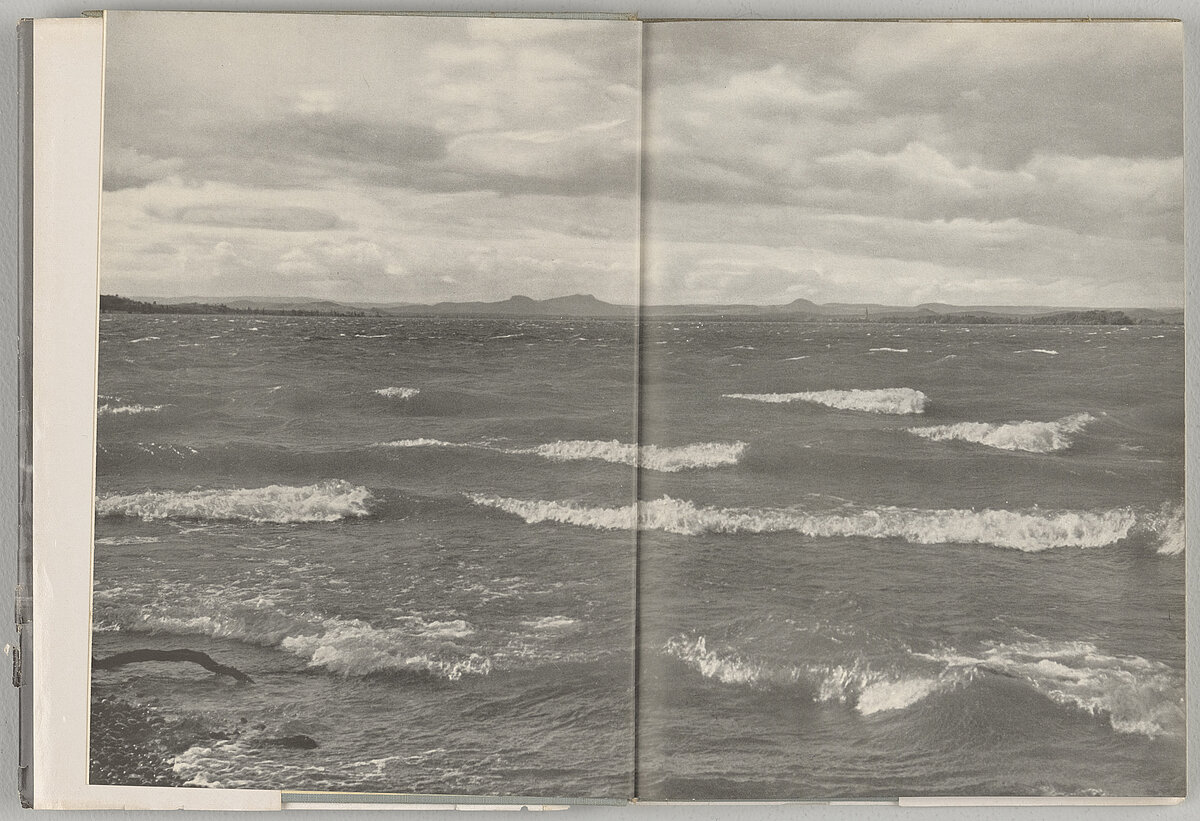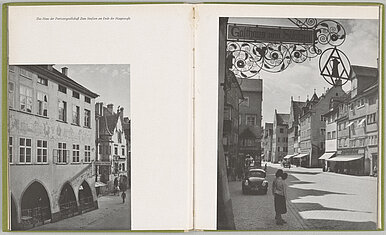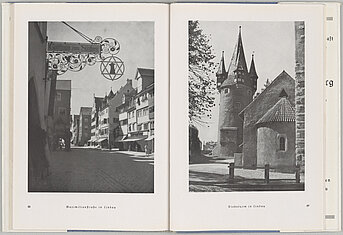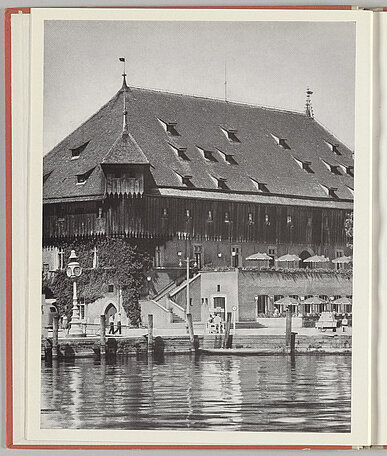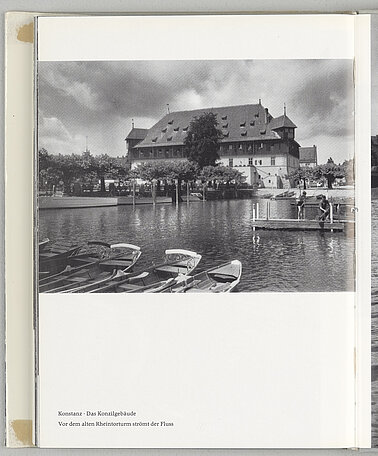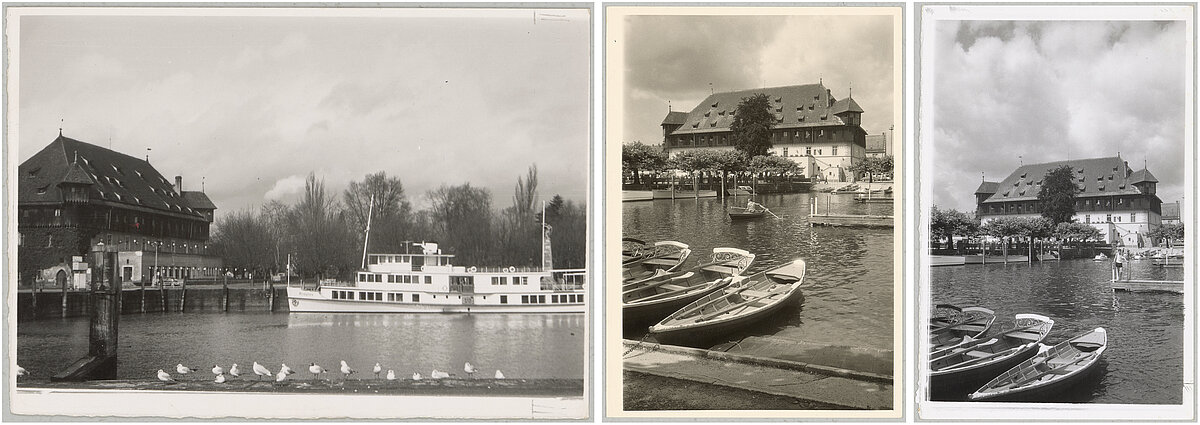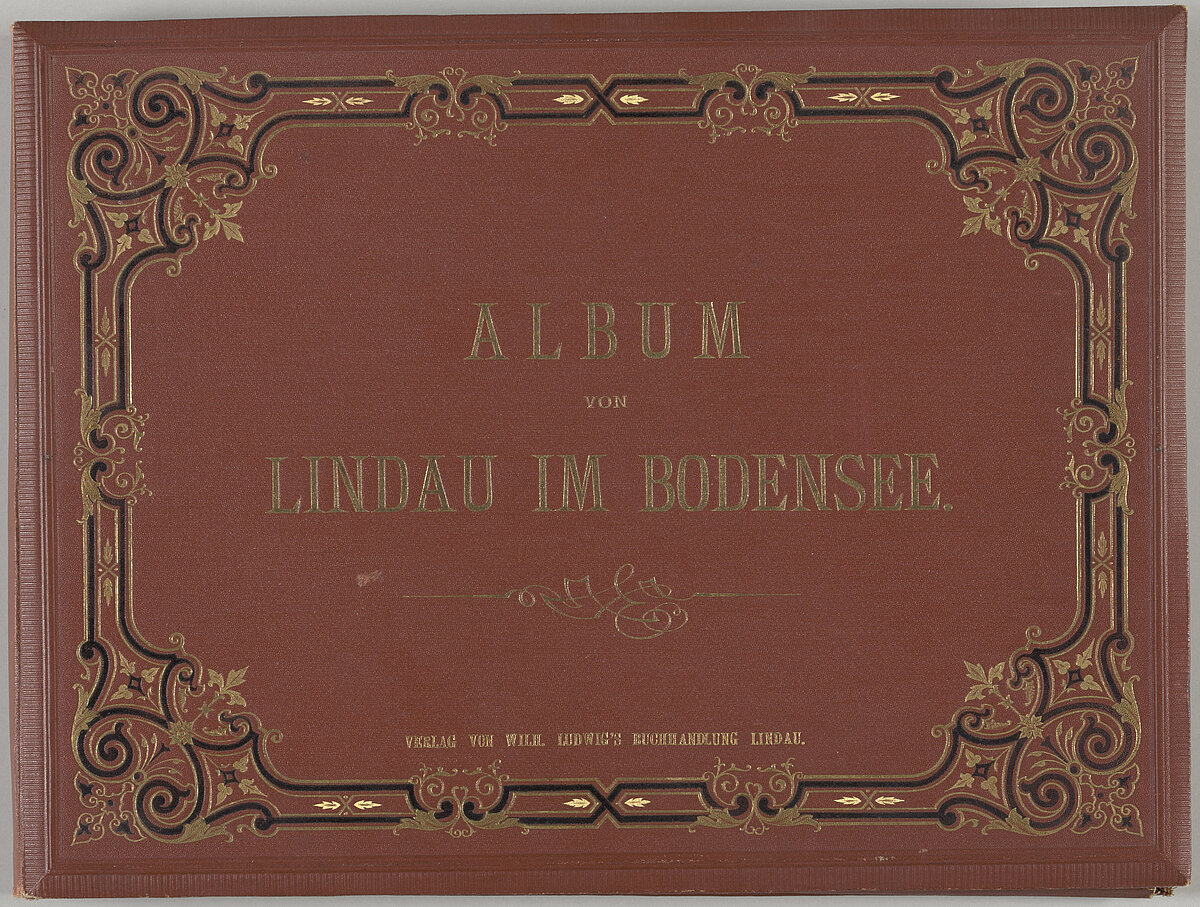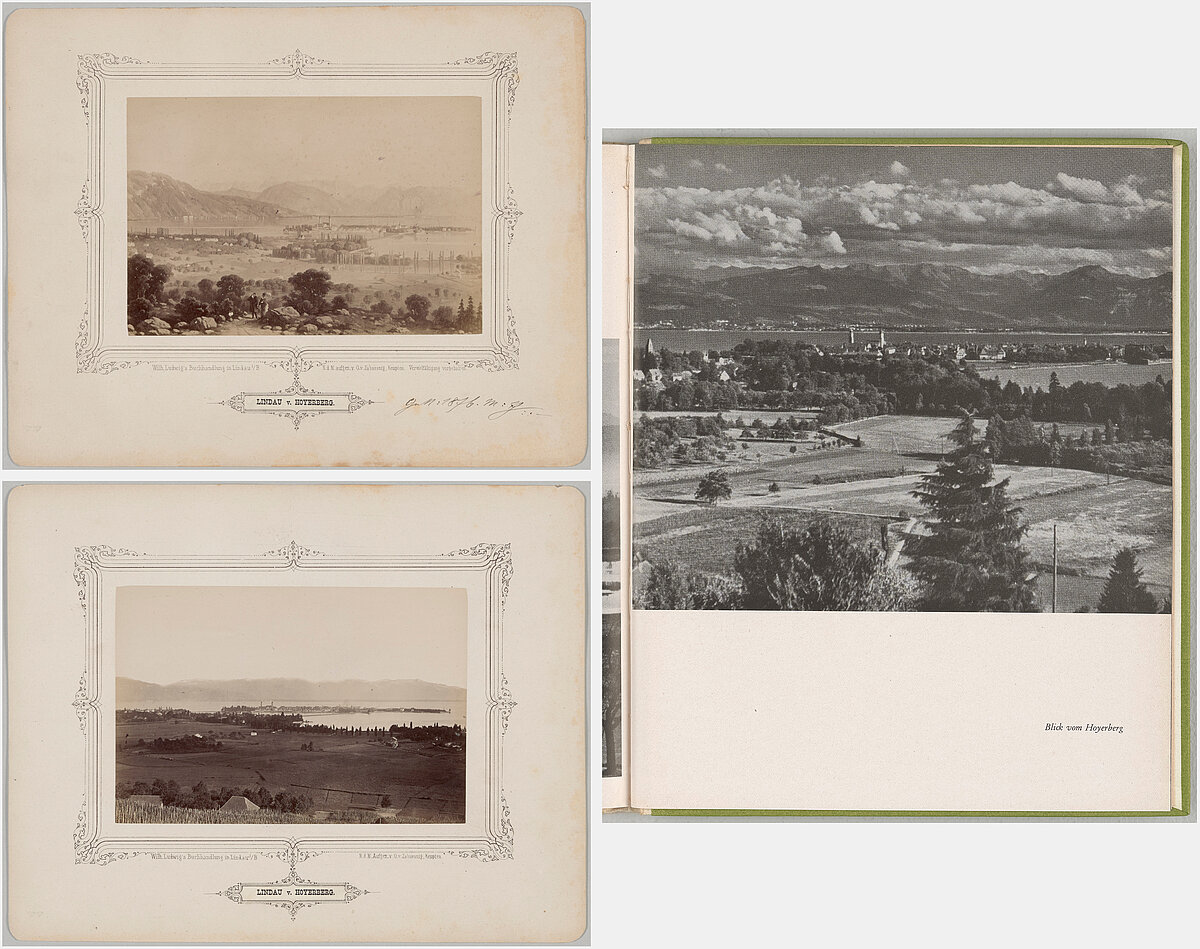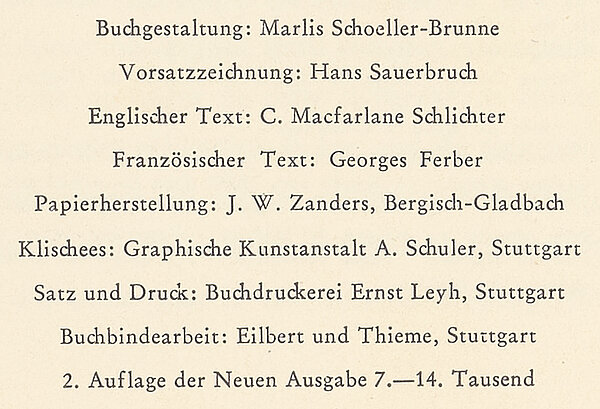Lotte Eckener (1906–1995) was a German photographer and publisher who between the 1930s and 1960s was predominately active in the Lake Constance region in southern Germany. For an introduction to her work and an overview of the holdings of the photography collection at the Münchner Stadtmuseum, see In Focus: Lotte Eckener and the Münchner Stadtmuseum. Eckner published the photo book Bodensee: Landschaft und Kunst (Lake Constance: Landscape and Art) between 1935 and 1963. You can read a discussion of the development of the book over four decades in Lotte Eckener’s Book on Lake Constance over the Decades.
In addition to Lotte Eckener, who was born in the Lake Constance region, Jeannine LeBrun (1915–1977) and Erna Stübel (no dates available) were active in the region starting in the 1930s, and Heinz Hajek-Halke (1898–1983) lived in the region until 1955, after working as a photographer at the Dornier-Werke in Friedrichshafen.[1] Siegfried Lauterwasser (1913–2000) continued his family’s studio in Überlingen, while Toni Schneiders (1920–2006) was active in Meersburg and then in Lindau.[2] Like Eckener, many of these photographers produced photographs for photo books that focus on cities and landscapes around Lake Constance; it is instructive to examine how these books differ from Eckener’s book on Lake Constance.
A Photographic Expedition around Lake Constance?
Starting in 1950, the cover of Eckener’s book on Lake Constance featured a map that presented the region as part of the three-country border between Germany, Austria, and Switzerland and included important cities, rivers, and sections of the lake. The integration of a map raises the question of how the book is structured.
The sequence of illustrated sites follows the geographical order, creating a rough route around the lake. Although this route varied in the different editions of the book, the version of 1950 presents a particularly logical route beginning in the west, following the northern shore through surrounding regions to Bregenz, and ending in Constance after passing around the southern side.
The concept of a journey is directly addressed in the text by Heiner Ackermann, animating readers to turn the pages and in doing so to continue their journey. Individual statements make direct reference to the images: “See the little chapel at Kattenhorn Palace!”[3]
Only to a certain extent is the sequence of images faithful to the first impression that the book entails a photographic journey around Lake Constance. Although the photographs are organized in groups according to location, these sequences do not enable the viewer to explore individual cities and sights in detail. For example, in the 1950 edition, the city of Meersburg is represented in five consecutive photographs: a view from the lake, a wood carving from a chapel in the lower city, a view of the gate of Meersburg Castle, a room inside the castle in which German poet Annette von Droste-Hülshoff (1797–1848) lived starting in 1841, and a view of the lake from the city. The structure of this sequence of photographs—moving from the lake to the city, individual buildings, and then a view of the lake again—is used in locations that are considered more significant.
Other places are only represented by individual historical landmarks, artworks, or characteristic landscapes. The Austrian city of Bregenz, for example, is only represented with one image showing the Martinsturm. This tower is still one of the city’s most well-known landmarks and is currently featured on the city’s official website.
Photo Books on Lake Constance
Siegfried Lauterwasser, Jeannine LeBrun, and Toni Schneiders all published books on Lake Constance in the 1950s. These books were all issued by the publishing house Jan Thorbecke Verlag, which was founded in Lindau in 1948 by Jan Thorbecke (1912–1963). The publishing house released a numbered series of picture books for tourists entitled “Picture Books on Southern Germany, Lake Constance Series” and “The Books on Lake Constance.”
The thin hardcover volumes generally focus on a single city such as Lindau, Constance, Meersburg, or Überlingen. The graphic design makes them readily recognizable as a series, and each cover features a representative local landmark. The contents also reflect a similar layout: a city map with street names and important buildings makes it easy to find the locations of the photographs, which always have descriptive titles.
Lindau, Constance, Lake Constance—A Comparison of Images
The audio commentaries discuss similarities and differences between the books published by Thorbecke Verlag and Eckener’s book on Lake Constance: while the organization and design differ, there are parallels in the choice of images and compositions. The different structure of the books is striking.[4]
Tourism in the Lake Constance Region
The repeated depiction of major landmarks suggests that all these books should be categorized within the context of tourism. The advent of travel in the late eighteenth century coincides with the establishment of touristic interest in the foothills of the Alps including Lake Constance, which continues to this day.[5]
Although recent exhibitions have examined a range of touristic images of Lake Constance, including woodcuts and veduta painting, photography has always been excluded.[6] After photography had begun to be used for touristic purposes in the 1840s, technical developments in the second half of the nineteenth century resulted in an increase in travel photography and its commercial use. The Album von Lindau im Bodensee (Album of Lindau on Lake Constance), an album from the collection of the Münchner Stadtmuseum that was published in 1873 by the Verlag von Wilhelm Ludwigs Buchhandlung Lindau, provides a good example of this.[7] The audio commentary explains the structure of the album.
The “construction” of the landscape of Lake Constance through photography follows the tradition of touristic images in which prints, vedutas, and brochures employ two modes of depiction that have already been mentioned in the discussion of the photographs: the panoramic view of the shore seen from the lake and the slightly raised perspective from the other side with a view of the city and the lake behind it. Other motifs such as harbors, sailboats, seagulls, and snow-covered mountains as well as motorships, swans, and fruit trees can be considered “canonized” touristic motifs from Lake Constance.[8] The dispositif[9] of tourism requires a certain selection of motifs with repeating compositions. While the cultural and social expectations of travel and landscape can be inferred from this, the photographic possibilities are limited in terms of what landscape photography is able to represent in the mid-twentieth century. It is important to notice what is depicted and what is left out.
Looking at Lotte Eckener’s landscape photographs, it is striking how often she emphasized clouds or retouched them out of the picture. In the video, artist and book designer Helmut Völter talks about Lotte Eckener's use of clouds.
The Boom: Print Runs and the Function of the Photo Books in the 1950s
Independent of their design, all the abovementioned photo books were in high demand in the 1950s, as is proven by the fact that new editions were reprinted multiple times.[10] Eckener’s 1950 book on Lake Constance was published in a slightly revised edition in 1950, bringing the total number of published copies on the market to fourteen thousand.[11] This remarkably high print run proves the interest in photo books on Lake Constance in the postwar period. The touristic images ignore the unpleasant aspects of everyday life in the postwar period with memories of war crimes and economic challenges such as the destroyed city centers and the social conflicts of the young Federal Republic of Germany. In a decade in which Heimatfilme were booming, photo books facilitated the imaginary return to a preindustrial age. Such souvenirs of a trip to Lake Constance were a welcome distraction from mundane topics, in which many Germans were directly involved as perpetrators.
Despite the large print runs and successful sales of her books, Lotte Eckener is not a well-known photographer today—unlike Siegfried Lauterwasser or Toni Schneiders, who published similar photo books with Thorbecke Verlag. Another essay takes a critical look at Eckener’s role in the historiography of photography and its significance for museum work.
Endnotes
[1] On Jeannine LeBrun, see Dorothea Cremer-Schacht, “Ihre Liebe galt den schönen Dingen des Lebens: Ein Portrait über die Fotografin Jeannine Le Brun,” in Jahrbuch des Landkreises Lindau 22 (Aulendorf/Bergatreute: Eppe, 2007), 58–69. The Deutsches Dokumentationszentrum für Kunstgeschichte, Bildarchiv Foto Marburg, has large holdings. On Heinz Hajek-Halke, see Michael Ruetz, ed., Der Alchimist: Heinz Hajek-Halke, exh. cat., Akademie der Künste, Berlin (Göttingen: Steidl, 2012).
[2] On Lauterwasser and Schneiders, see Alexander Lauterwasser, Augen-Blicke: Das Lebenswerk des Überlinger Photographen Siegfried Lauterwasser (Überlingen: Foto Lauterwasser, 2013); Sebastian Lux, ed., Schaut her! Toni Schneiders, exh. cat., Stiftung F. C. Gundlach, Hamburg; Versicherungskammer Kulturstiftung, Munich (Göttingen: Steidl, 2020); and Ulrich Pohlmann and Josef Adolf Schmoll gen. Eisenwerth, eds., Toni Schneiders: Photographien 1946–1980, exh. cat., Fotomuseum im Münchner Stadtmuseum, Munich (Munich: Schirmer/Mosel, 1999).
[3] Text by Heiner Ackermann in Lotte Eckener, Bodensee: Landschaft und Kunst (Kattenhorn: Schoeller-Bild Kunstverlag, 1950), 15.
[4] An audio commentary refers to the gondola harbor that along with two lookout towers, a colony of swans, and a music pavilion was designed in the nineteenth century to enhance the experience. See Werner Trapp, Mit Blick auf See und Gebirge: Der Bodensee—Bilder vom Wandel einer touristischen Landschaft (Karlsruhe: G. Braun, 2002), 16.
[5] On the history of tourism in the Lake Constance region, see Tobias Engelsing, “‘Wir lebten im Zauber einer anderen Welt’: Die literarische und touristische Erschließung der Landschaft zwischen Säntis und Rheinfall,” in Engelsing, ed., Idyllen zwischen Berg und See: Die Entdeckung von Bodensee und Voralpenraum, exh. cat., Rosgartenmuseum, Constance (Constance: Südverlag 2021), 8–63.
[6] The exhibition Idyllen zwischen Berg und See at the Rosgartenmuseum in Constance in 2021, for example, presented early prints from around the Lake Constance region; see Engelsing, Idyllen zwischen Berg und See. Another exhibition at the Museum Lindwurm in Stein am Rhein in 2019, titled Tourismuswerbung über Grenzen 1890 bis 1950, examined the visual history of advertising in international tourism, presenting ephemeral printed matter such as advertising brochures, maps, and posters depicting Lake Constance and the Rhine; see Elisabeth Schraut, Bodensee und Rhein: Tourismuswerbung über Grenzen 1890–1950, exh. cat., Museum Lindwurm, Stein am Rhein (Stein am Rhein, 2019).
[7] See the advertisements in the Lindauer Tagblatt für Stadt und Land, November 22, 1873, no. 274, unpaginated. As early as 1867 the publisher Verlag M. Riegersche Buch- und Kunsthandlung advertised an album of Lindau with six photographs; see advertisement in the Lindauer Tagblatt für Stadt und Land, July 19, 1867, no. 170, p. 798. Handwritten notes on the back of several of the album pages give the year as 1877, although this could be a record of the year of the writer’s visit.
[8] On fruit trees and motor ships, see Engelsing “‘Wir lebten im Zauber einer anderen Welt,’” 8–63, esp. 22; and Schraut Bodensee und Rhein, 11. The swans are discussed in Trapp, Mit Blick auf See und Gebirge, 10 and 16.
[9] The term dispositif, coined by French philosopher Michel Foucault, describes the sum of institutions, laws, discourses, and social practices through which knowledge is produced and power is exercised. See D. Colas et al., “Le jeu de Michel Foucault,” Ornicar? Bulletin périodique du champ freudien 10 (1977): 62–93.
[10] Toni Schneider’s Lindau, for example, was published in 1950 and 1952, and in a new edition in 1959.
[11] Although the next edition of the Lake Constance book did not appear until 1959, Eckener was busy with the book Das kleine Buch vom Bodensee, which was published in three editions between 1954 and 1958 by the publisher Verlag Simon und Koch with a total print run of twenty thousand.
About the author
Clara Bolin is an art and photography historian. Between 2023 and 2025, she serves as a fellow in the Museum Curators for Photography program of the Alfried Krupp von Bohlen und Halbach-Foundation, working within the Münchner Stadtmuseum’s Photography Collection. Her interest in Lotte Eckener builds on earlier projects focused on post-war photography and the role of women photographers.
Date of pubishing
June 27, 2024
Translation by Tas Skorupa
Plan Your Visit
Opening hours
Although the Münchner Stadtmuseum's exhibitions closed on January 8, 2024, for a complete renovation, the cinema and the Stadtcafé will remain open to visitors until June 2027.
Information to Von Parish Costume Library in Nymphenburg
Filmmuseum München – Screenings
Tuesday / Wednesday 6.30 pm and 9 pm
Thursday 7 pm
Friday / Saturday 6 pm and 9 pm
Sunday 6 pm
Contact
St.-Jakobs-Platz 1
80331 München
Phone +49-(0)89-233-22370
Fax +49-(0)89-233-25033
E-Mail stadtmuseum(at)muenchen.de
E-Mail filmmuseum(at)muenchen.de
Ticket reservation Phone +49-(0)89-233-24150

